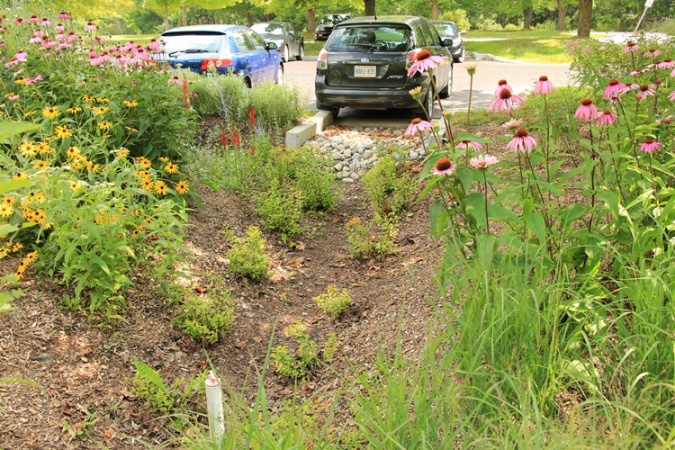Difference between revisions of "Bioretention"
Jenny Hill (talk | contribs) |
Jenny Hill (talk | contribs) |
||
| Line 21: | Line 21: | ||
*Impermeable membrane to prevent infiltration to soils below | *Impermeable membrane to prevent infiltration to soils below | ||
</p> | </p> | ||
| + | |||
| + | </div> | ||
| + | <div class="col-md-4"> | ||
| + | |||
| + | <panelSuccess> | ||
| + | <gallery mode="packed" widths=300px heights=300px> | ||
| + | IMG 2457 750X500.jpg| Bioretention cell capturing and treating runoff from adjacent parking lot at the Kortright Centre, Vaughan. | ||
| + | </gallery> | ||
| + | </panelSuccess> | ||
</div> | </div> | ||
| Line 34: | Line 43: | ||
</table> | </table> | ||
| − | |||
| − | |||
| − | |||
| − | |||
| − | |||
| − | |||
| − | |||
| − | |||
| − | |||
| − | |||
| − | |||
---- | ---- | ||
Revision as of 00:28, 26 June 2017
This article is about planted installations designed to capture surface runoff through an engineered soil with subterranean infrastructure.
For simpler, residential systems, see Rain Gardens.
For linear systems, which convey flow, but are otherwise similar see Bioswales.
Overview[edit]
Bioretention cells are one of the most well recognized form of Low Impact Development. They can encompass all mechanisms of action: infiltration, filtration and evapotranspiration.
Bioretention cells are an ideal technology for:
- Fitting functional vegetation into urban landscapes
- Treating runoff collected from nearby impervious surfaces
The fundamental components of a bioretention cell are:
- Biomedia: An engineered soil mix
- Planting
- Storage layer of coarse aggregate
- Under-drain to redistribute or remove excess water
- Impermeable membrane to prevent infiltration to soils below
<panelSuccess>
</panelSuccess>
| Form | Characteristics | Examples |
|---|---|---|
| Infiltrating Cells | Used in developments with large landscaping areas, parks, parking lot islands, or any areas without tight space constraints. They have side slopes ≥2:1. Often, they receive sheet flow, but in some cases they are surrounded by curbs and will have inlets. The distinction between these options will determine the recommended types of pre-treatment. | Image here |
| Rain Gardens | Often found on residential sites or on land managed by community organisations . This simple variation may be constructed by the property owner and usually excludes the storage layer. | Image here |
Planning Considerations[edit]
Planning Content
<panelSuccess>
</panelSuccess>
Design[edit]
Design Content
<panelSuccess>
</panelSuccess>
Performance[edit]
Performance Content
<panelSuccess>
</panelSuccess>
Incentives and Credits[edit]
In Ontario
City of Mississauga
The City of Mississauga has a stormwater management credit program which includes RWH as one of their recommended site strategies[1].
LEED BD + C v. 4
SITES v.2
See Also[edit]
External Links[edit]
| SEND US YOUR QUESTIONS & FEEDBACK ABOUT THIS PAGE |
